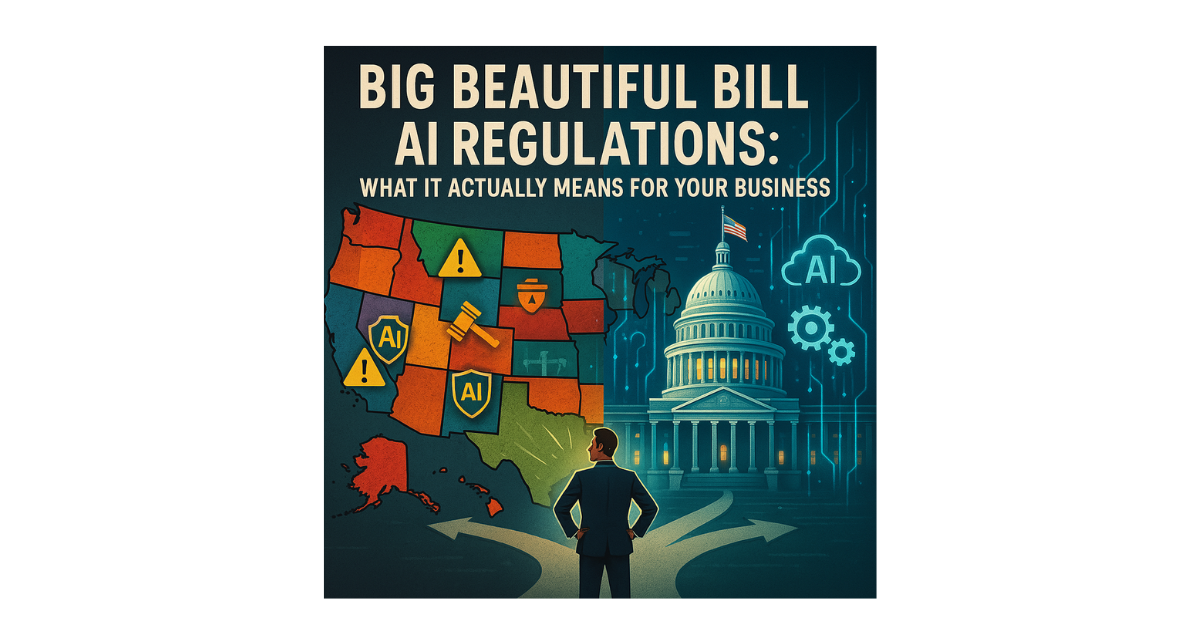The Big Beautiful Bill has reshaped the AI regulatory landscape, introducing both challenges and opportunities for businesses navigating this rapidly evolving space. As federal and state regulations continue to unfold, organizations must not only ensure compliance but also oversee the outputs of AI systems to adhere to ethical, transparent, and safe standards.
This blog explores the bill's key provisions, the Senate's influence on its framework, and actionable strategies for businesses to navigate compliance while effectively managing AI outputs.
Key Goals of the AI Subpart of The Big Beautiful Bill
The AI-focused portion of the Big Beautiful Bill was introduced to establish a cohesive, nationwide framework for AI regulation. Its main objectives include fostering innovation, ensuring ethical AI development, and protecting consumers.
Initially, the bill proposed a centralized federal model to create uniform standards, simplifying compliance for businesses operating across states. It also allocated significant federal funding to support public and private AI initiatives, incentivize ethical AI practices, and enhance oversight capabilities.
A central focus of the bill is oversight—not just of AI systems, but also their outputs. With AI increasing in complexity, businesses must ensure that the results produced by these systems align with ethical principles, reduce bias, and remain compliant with both federal and state regulations.
The State Moratorium Debate: A Patchwork of Regulations
One of the most debated aspects of the bill was the proposed ten-year moratorium on state-level AI regulations. The idea was to streamline AI governance by preventing states from introducing their own rules, creating a unified regulatory environment. However, because of the concerns about states' rights and the need for local flexibility, the US Senate has voted for the removal of a proposed ban on state artificial-intelligence regulations from the current administration’s budget mega bill, saying local authorities are better placed to safeguard data privacy. The moratorium would have derailed hundreds of state laws, including those already in force, focused on preventing misuse of personal data, deepfakes, and AI-powered data breaches.
As a result, businesses now face a fragmented regulatory landscape. States like California, New York, and Illinois have already implemented comprehensive AI regulations addressing data privacy, algorithmic fairness, and transparency. For companies operating in multiple jurisdictions, this diversity adds complexity, requiring tailored and adaptive compliance strategies and robust oversight mechanisms. You can track the various legislations by state at the International Association of Privacy Professionals (IAPP) website here.
Navigating Multi-Jurisdictional Compliance
With the removal of the state-level ban, businesses must deal with different AI regulations in each state and country. This means they need to take a proactive approach to staying compliant across multiple jurisdictions.
- Centralized Compliance Systems: Develop a unified compliance framework adaptable to local requirements.
- Cross-Border Safeguards: Ensure data flows and AI outputs comply with the strictest applicable standards, such as the EU’s AI Act, GDPR or California’s CCPA.
- Ongoing Adaptation: Continuously update compliance strategies to address new regulations and standards.
Federal Investments in AI: Supporting Innovation and Oversight
Despite the debates over state versus federal authority, the bill preserved its substantial federal funding provisions, allocating billions of dollars to AI initiatives across various agencies. These investments aim to drive innovation, improve infrastructure, and enhance oversight:
- Department of Homeland Security: $6.1 billion for AI-driven border and inspection systems.
- Defense: Funding for autonomous drones, cyber defense, and other AI applications.
- Department of Commerce: $500 million for AI infrastructure and broadband expansion.
- Energy Sector: $150 million for AI-driven renewable energy and grid management.
These investments not only encourage innovation but also provide businesses with opportunities to leverage government-supported resources to improve their compliance and oversight capabilities.
The Role of Oversight in AI Compliance
As AI systems become more integral to business operations, overseeing their outputs is essential for compliance with the Big Beautiful Bill. The outputs of AI—whether in decision-making, recommendations, or predictions—must adhere to ethical standards, minimize bias, and align with regulatory requirements.
Without effective oversight, businesses risk deploying AI systems that unintentionally produce harmful, biased, or non-compliant results. This can lead to reputational damage, legal penalties, and loss of consumer trust.
Building a Robust AI Oversight Framework
To meet the bill’s requirements and ensure the responsible use of AI, businesses need a strong oversight framework. This involves monitoring AI systems throughout their lifecycle, from development to deployment, and beyond. Key steps include:
- Ensuring Ethical AI Outputs
Develop and implement guidelines to ensure AI-generated outputs are fair, transparent, and free of bias. Regularly test and validate AI models to identify and address potential risks. - Establishing Governance Teams
Create dedicated AI governance committees to oversee the ethical use of AI. These teams should include technical experts, legal advisors, and business leaders to provide a well-rounded perspective. - Monitoring AI Outputs in Real Time
Use advanced monitoring tools to track AI outputs continuously. Automated tools can detect anomalies, identify compliance risks, and flag issues for further review. - Conducting Regular Audits
Perform both internal and external audits to evaluate the effectiveness of AI systems and their outputs. Document all processes to demonstrate compliance during regulatory reviews. - Educating Employees
Train employees across all levels on AI compliance and oversight. This ensures that technical and non-technical teams understand their role in maintaining ethical and compliant AI practices.
Leveraging Technology for Oversight and Compliance
Managing AI oversight at scale requires the right technology. Traditional methods are no longer sufficient to address today’s complex regulatory demands. Tools like Bonfy’s Adaptive Content Security™ Platform (Bonfy ACS™) are designed to help businesses manage AI compliance and oversight effectively.
Key Features of Bonfy ACS:
- AI-Powered Risk Detection: Automatically identify risks in AI outputs, such as privacy violations or non-compliance, without relying on outdated pattern-matching techniques.
- Real-Time Policy Enforcement: Enforce compliance policies proactively, preventing non-compliance before it becomes an issue.
- Seamless Integration: Bonfy ACS integrates with tools like Microsoft 365, Salesforce, HubSpot and Slack, making it easy to monitor AI outputs across workflows.
By leveraging such platforms, businesses can maintain compliance while optimizing the potential of AI systems.
TL:DR
AI regulations will continue evolving as technology advances. Organizations must remain agile, monitoring changes, and refining oversight and compliance strategies. Engaging in regulatory discussions and consulting experts can provide valuable insights and help shape future policies.
Proactive risk management and regular updates to AI governance frameworks will ensure businesses stay ahead of regulatory changes while fostering innovation. By investing in robust governance frameworks and leveraging advanced yet simple to deploy tools like Bonfy, businesses can confidently deploy AI while meeting regulatory requirements.






